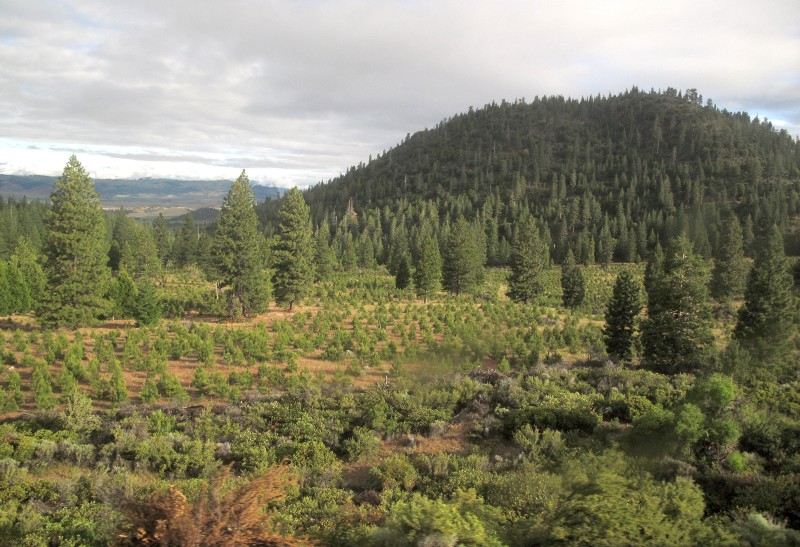

Trying to hack our atmosphere to fix climate change is, in most cases, a terrible idea. There’s no technological magic bullet that remedies the fact that we’re filling the skies full of heat-trapping greenhouse gases. Last week, we presented a few examples of dangerous ideas for tweaking natural systems on a grand scale.
But not all geoengineering schemes are harmful–there are a few based on solid science that don’t involve screwing around with systems we don’t fully understand. Here are five ideas that just might help us reduce the impacts of climate change.

1. Plant loads of trees
Reforestation is one of the greatest tools we have to address climate change. As a tree grows, it sucks carbon dioxide out of the air–so the more trees growing around the world, the more carbon is taken out of the atmosphere. We could even enlist drones to help in the planting process. When trees die this carbon is released again, but this effect can be reduced and the carbon sequestered permanently by turning fallen trees into biochar.
Of course, preventing deforestation is crucially important, too. It does little good to plant loads of trees if someone else is going to cut them all down–not to mention that deforestation causes extinction, desertification and population displacement. As such, many international organizations have programs aimed at reducing deforestation, using satellites to monitor tree coverage around the globe and aiming resources where they’ll make a difference. If nothing else, a switch from slash-and-burn to slash-and-char could dramatically reduce the emissions from deforestation.

2. Capture carbon and store it
Just as trees suck carbon dioxide out of the air and stash it in the ground, we can as well–ideally before it even arrives in the atmosphere. Carbon capture and storage is a technique where large sources of carbon (like big fossil fuel power plants) are equipped with filters that capture carbon dioxide. The captured gas can then be transported to a storage site and deposited somewhere that it won’t re-enter the atmosphere–usually an airtight geological formation.
One of the most promising applications of this technology is when it’s applied to biofuels. Plants draw carbon out of the atmosphere when they grow but release it when they’re burned–so if you can capture the released carbon when the plants are set aflame and store it below ground, you’ll be permanently removing that carbon from the climate.

3. Paint rooftops white
As we examined in depth a couple of months ago, painting rooftops white is a viable method for fighting climate change. Why? Because white roofs reflect sunlight back out into space. Cities are usually hotter than the areas surrounding them because they’re darker–and darker objects, as anyone who’s parked a car in the sun knows, absorb more energy. A dark roof, for example, reflects just 20 percent of sunlight, while a white one reflects 80 percent, beaming the rest straight back out through the atmosphere into space.
The Global Cool Cities Alliance wants to extend this principle beyond rooftops to also include sidewalks. One paper, published in 2010, found that making roofs and pavements brighter in cities of more than a million people in the Northern Hemisphere could offset a stunning 127.9 trillion pounds of CO2 emissions–and since global CO2 emissions for the whole of 2014 came to 70.5 trillion pounds, that’s enough to offset nearly two years’ worth of carbon dioxide.

4. Fly less
Taking a train or bus instead of a plane or car is an obvious way of reducing the amount of carbon dioxide in the atmosphere, as it means emissions are lower per person. But that’s not really geoengineering. Or is it?
Under the right conditions, planes produce contrails, which spread out into wispy cirrus clouds high in the atmosphere. While low clouds tend to have a negative effect on climate change (because their white bodies reflect more energy back into space than they trap beneath them), high clouds are the opposite–particularly at night and during the winter.
We have good proof of this: After September 11, 2001, when planes across the United States were grounded for three days, climatologists were able to quantify the effects of aviation on the climate. They found that without contrails, the difference between day and night temperatures was almost two degrees Fahrenheit (1 degree Celsius) greater than immediately beforehand, proving the heat-trapping effects of aviation.

5. Use carbon-negative cement
Cement production is a huge source of carbon dioxide emissions to the atmosphere. It not only requires intense heat to cook the raw materials, but those materials also release further CO2 as they burn. Thankfully, there’s an alternative.
A London-based firm called Novacem invented a carbon-negative cement in 2008 based on magnesium silicates, which not only requires much less heat to produce but actually sucks CO2 out of the atmosphere as it hardens. The company said its product can absorb, over its lifecycle, about 60 pounds of CO2 per every 100 pounds of cement–compared to about 40 pounds of CO2 per 100 of normal cement. Unfortunately, Novacem went bankrupt before it could commercialize the technology; the good news is that a mystery Australian buyer subsequently acquired the rights to the invention.


How We Get To Next was a magazine that explored the future of science, technology, and culture from 2014 to 2019. This article is part of our Nature & Climate section, which looks at how human activity is changing the planet–for better or worse. Click the logo to read more.
